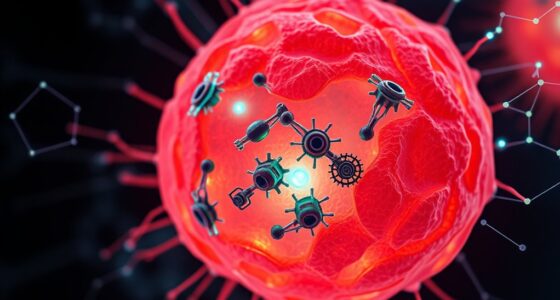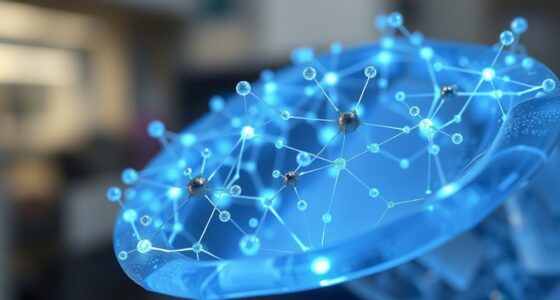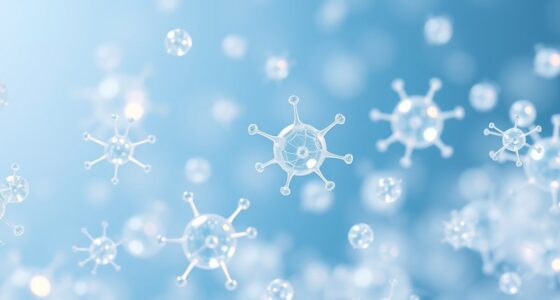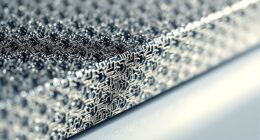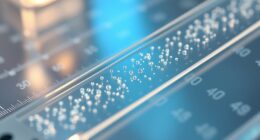Nanomachines are tiny devices designed to deliver CRISPR components precisely to target cells, improving gene therapy effectiveness. They navigate biological barriers, protect the genetic material, and can be customized to seek out specific tissues or cell types. Using intelligent design and biocompatible materials, they aim to reduce side effects and enhance safety. If you explore further, you’ll discover how recent breakthroughs are transforming genetic treatments and what the future holds for this innovative technology.
Key Takeaways
- Nanomachines enable targeted delivery of CRISPR components, protecting them from degradation and enhancing cellular uptake.
- Surface functionalization with ligands improves nanomachine specificity to target tissues or cell types.
- Responsive nanomachines utilize external stimuli like magnetic or light fields for controlled activation and release.
- Advances focus on improving biocompatibility, minimizing immune responses, and ensuring safe, efficient gene editing.
- Future developments aim for precision, personalized therapies, and integration with AI for optimized gene delivery systems.
The Science Behind Nanomachines in Medicine

Nanomachines in medicine operate at a scale so tiny that they can interact directly with individual cells and molecules. This small size allows them to perform precise tasks, like targeting specific cell types or delivering drugs to exact locations. Made from advanced materials, these nanomachines can move, recognize, and respond to biological signals. They use energy sources such as chemical reactions or external stimuli like magnetic or light fields to operate. Their design often mimics biological systems, enabling seamless integration within the body. This technology relies on principles from physics, chemistry, and biology to manipulate matter at the nanoscale. Their ability to perform targeted delivery enhances treatment effectiveness and reduces side effects. By understanding these scientific foundations, you can appreciate how nanomachines revolutionize medicine, making treatments more targeted, effective, and minimally invasive.
How Nanomachines Enhance CRISPR Delivery
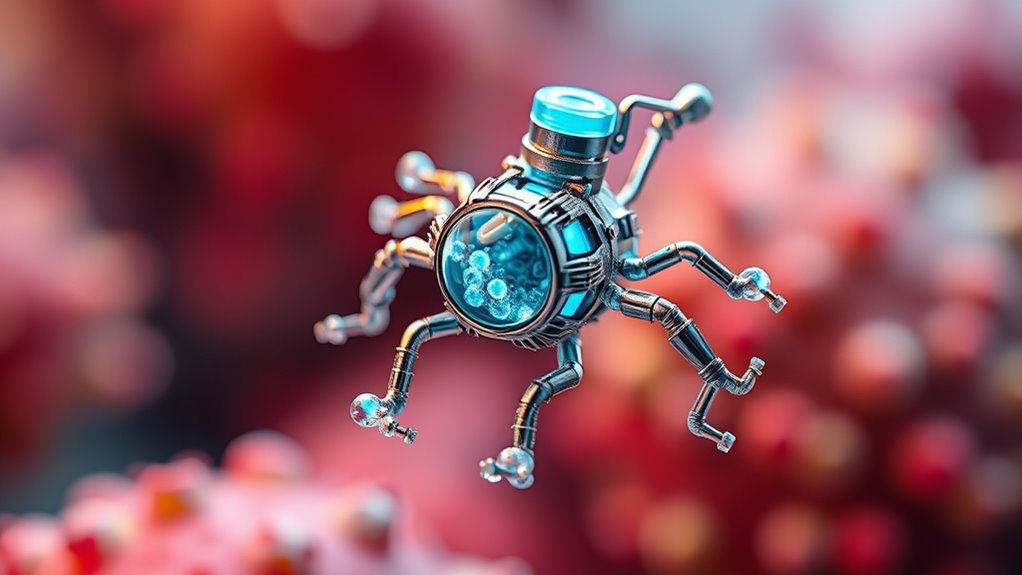
Nanomachines markedly improve CRISPR delivery by overcoming challenges related to stability and targeting. They protect CRISPR components from degradation in the bloodstream, ensuring the gene-editing tools reach your target cells intact. By precisely controlling surface properties, nanomachines can navigate biological barriers and avoid immune detection. This enhances the efficiency of delivery to specific tissues or cell types, reducing off-target effects. Nanomachines also facilitate cellular uptake by promoting endocytosis, ensuring that CRISPR complexes enter cells effectively. Their customizable surfaces allow for functionalization with targeting ligands, guiding them directly to the desired site. Overall, nanomachines optimize the delivery process, increasing the likelihood of successful gene editing while minimizing side effects and maximizing therapeutic potential. Incorporating targeted delivery techniques from the field of personal development can further refine the precision and effectiveness of nanomachine-based therapies.
Designing Nanomachines for Targeted Gene Therapy
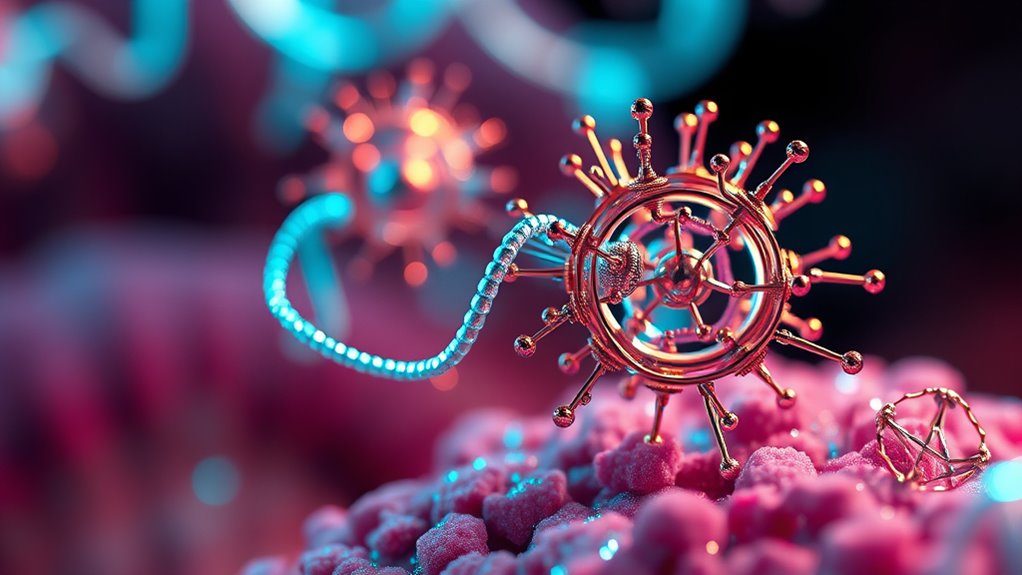
When designing nanomachines for targeted gene therapy, you need to focus on precision targeting strategies to ensure they reach specific cells or tissues. Choosing biocompatible materials is vital to minimize immune responses and enhance safety. By integrating these key points, you can improve the effectiveness and safety of your gene delivery systems. Additionally, considering potential vulnerabilities in nanomachine design can help preempt safety concerns and improve overall reliability.
Precision Targeting Strategies
Designing nanomachines for targeted gene therapy requires meticulous strategies that guarantee therapeutic agents reach specific cells or tissues while minimizing off-target effects. To achieve this, you can incorporate surface ligands or antibodies that recognize unique cell markers. These act as GPS, guiding nanomachines directly to their targets. Imagine a system where your nanomachine interacts with its environment like this:
| Target Marker | Ligand/Antibody | Cell Type |
|---|---|---|
| CD4 | Anti-CD4 | T helper cells |
| HER2 | Anti-HER2 | Breast cancer |
| Transferrin | Transferrin | Brain endothelial |
This tailored approach ensures precise delivery, maximizing therapeutic impact while reducing side effects. Properly designing these targeting strategies is key to advancing effective gene therapy. Additionally, understanding nanomachine compatibility with various biological environments can further improve targeting accuracy and therapeutic outcomes.
Biocompatible Material Selection
Selecting appropriate biocompatible materials is fundamental to creating effective nanomachines for targeted gene therapy. You need materials that won’t trigger immune responses or cause toxicity while maintaining stability in the bloodstream. Polymers like PEG and PLGA are popular because they are well-tolerated and can be engineered for specific delivery needs. Lipid-based materials, such as liposomes, offer excellent biocompatibility and membrane fusion capabilities. You should also consider surface modifications, like PEGylation, to reduce immune recognition. The choice of materials impacts the nanomachine’s circulation time, targeting precision, and safety profile. Carefully selecting biocompatible components ensures your nanomachine can reach target cells efficiently, deliver genetic payloads safely, and minimize adverse effects, making your gene therapy more effective and safer. Additionally, understanding the importance of biocompatibility in nanotechnology helps in designing materials that are less likely to provoke immune responses or toxicity.
Advantages of Using Nanomachines in Genetic Treatments
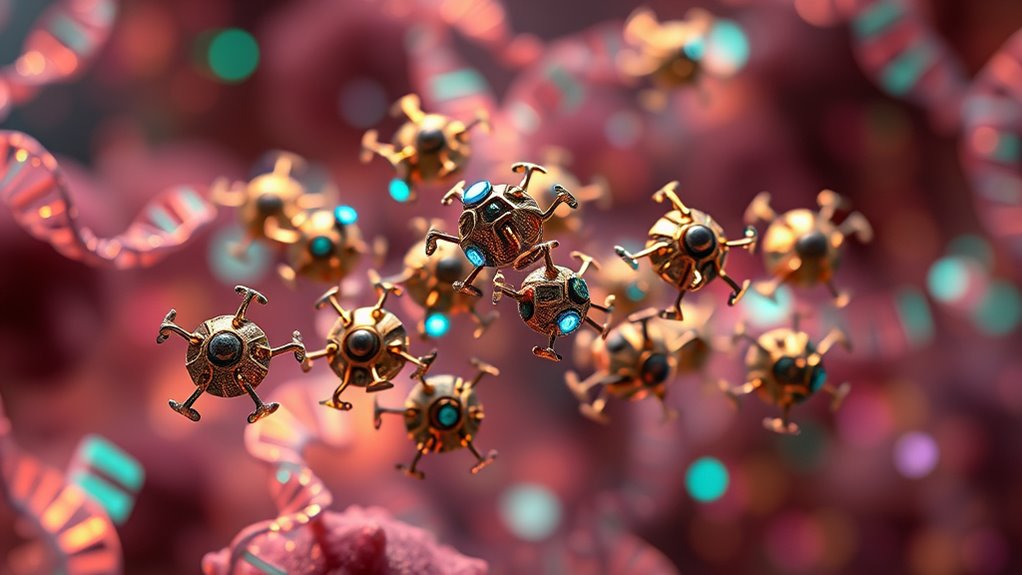
Have you ever wondered why nanomachines are gaining attention in gene therapy? They can target cells precisely, reducing side effects and increasing treatment efficiency. Nanomachines can navigate complex biological environments, delivering genes or CRISPR tools directly where needed. Their small size allows crossing biological barriers, such as the blood-brain barrier, that traditional methods can’t. This results in faster, more effective treatments. Consider the following advantages:
| Precision Targeting | Reduced Side Effects | Enhanced Delivery Efficiency |
|---|---|---|
| Directs therapy exactly where needed | Minimizes damage to healthy tissue | Improves gene editing success rate |
These benefits make nanomachines a promising tool, transforming genetic treatments into safer, more effective options. Utilizes AI to optimize targeting and delivery strategies, further enhancing treatment outcomes.
Challenges and Limitations of Nanomachine Technologies

While nanomachines show promise, you’ll face hurdles like delivery efficiency barriers that limit how well they reach target cells. Biocompatibility concerns also arise, as some materials may trigger immune responses or toxicity. Understanding and overcoming these challenges are vital for safe and effective gene therapy applications. Additionally, high refresh rates in imaging technologies can influence the development of advanced diagnostic tools and monitoring systems.
Delivery Efficiency Barriers
Despite the promise of nanomachines in gene therapy and CRISPR delivery, numerous barriers hinder their efficiency. One major challenge is crossing biological barriers like cell membranes and tissue barriers, which restrict delivery. Additionally, nanomachines often face degradation or clearance before reaching their target. Limited control over release timing and dosage also reduces effectiveness. To visualize, consider the table below:
| Barrier | Impact |
|---|---|
| Cellular membrane | Prevents entry of nanomachines |
| Immune clearance | Eliminates nanomachines early |
| Tissue penetration | Limits distribution in tissues |
| Controlled release | Challenges precise gene editing |
Addressing these issues is vital to enhance the delivery efficiency and unlock full therapeutic potential. Ensuring good lighting and cozy textiles can create a comfortable environment, much like overcoming delivery barriers in nanomachine technology.
Biocompatibility Concerns
Biocompatibility remains a vital challenge for nanomachine technologies in gene therapy and CRISPR delivery. Your nanomachines must evade immune detection, avoid toxicity, and prevent adverse reactions. If they’re recognized as foreign, your body could reject them, reducing effectiveness or causing harm. Ensuring materials are non-toxic and safe over long-term use is essential but difficult. You also need to consider potential accumulation in organs, which might lead to inflammation or damage. Achieving a balance between functionality and biocompatibility requires careful material selection, surface modification, and thorough testing. Without addressing these concerns, nanomachines risk failure, limited clinical application, or harmful side effects. Overcoming biocompatibility issues is vital for advancing nanotech-based gene therapies and ensuring patient safety. Incorporating Cultural Intelligence strategies can facilitate collaboration across multidisciplinary teams to develop safer, more effective solutions.
Recent Breakthroughs in Nanomachine Research
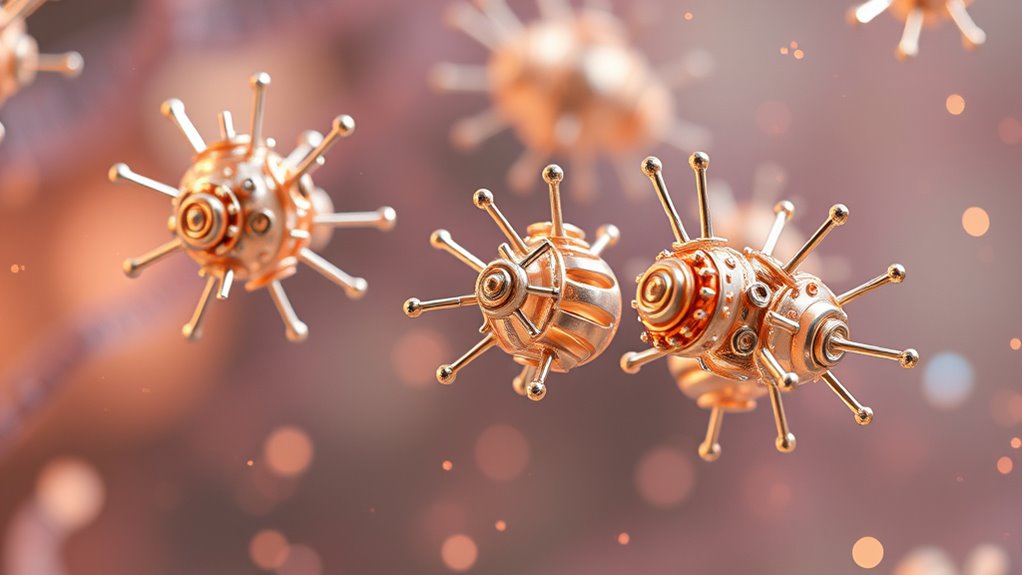
Recent advances in nanomachine research have revolutionized the way scientists approach gene therapy and CRISPR delivery. Researchers have developed highly precise nanomachines capable of targeting specific cells and releasing therapeutic agents with minimal off-target effects. Breakthroughs include the design of DNA origami nanostructures that can navigate biological environments and respond to stimuli like pH or enzymes. Additionally, magnetic and light-responsive nanomachines now offer controlled activation, improving delivery accuracy. Innovations in surface modification have enhanced stability and targeting efficiency, reducing immune responses. These advancements enable more efficient gene editing, lower dosages, and fewer side effects. Moreover, understanding the financial aspects involved in developing such advanced therapies can facilitate better funding and resource allocation, accelerating the translation of these innovations into clinical applications. Overall, recent research pushes the boundaries of nanotechnology, bringing us closer to safer, more effective gene therapies and CRISPR applications.
Future Perspectives and Potential Applications
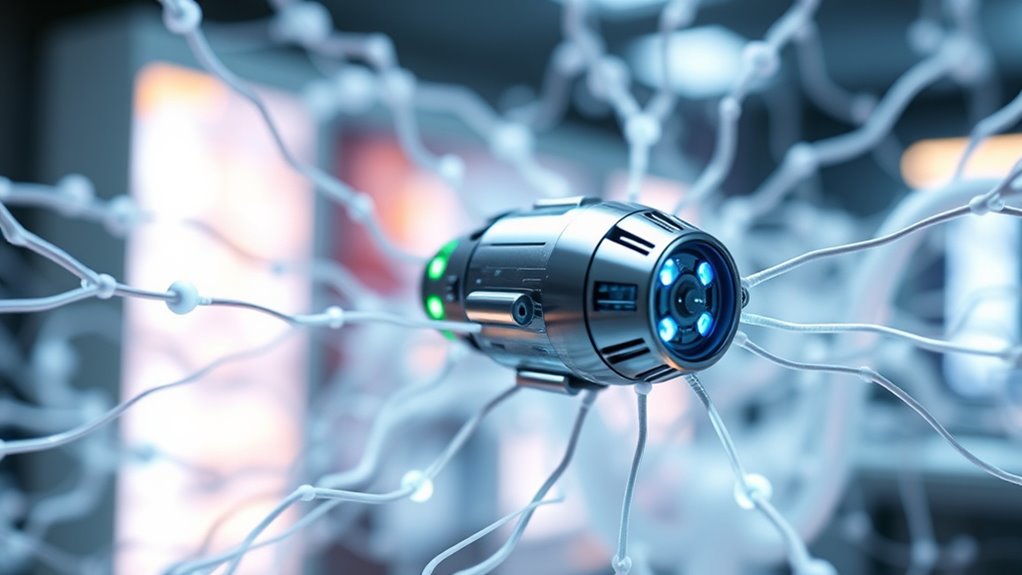
The rapid progress in nanomachine technology opens exciting possibilities for future gene therapies and CRISPR delivery systems. You could see targeted treatments that minimize side effects and improve efficiency, revolutionizing medicine. Nanomachines may enable precise editing of genetic disorders, even in hard-to-reach tissues. They could also facilitate personalized therapies tailored to individual genetic profiles. Additionally, these advancements might lead to new diagnostic tools that detect diseases early, guiding timely interventions. As research advances, you’ll likely witness nanomachines becoming integral to clinical applications, transforming healthcare. The potential to combine nanotechnology with other innovations, like AI, could further enhance treatment accuracy and safety. These developments promise a future where gene editing is faster, safer, and more accessible for everyone.
Nanomachines revolutionize gene therapy with precise, personalized, and minimally invasive treatments, enhancing diagnostics and integrating AI for safer, faster healthcare.
- Targeted gene editing with minimal invasiveness
- Personalized, patient-specific therapies
- Enhanced diagnostic capabilities
- Integration with AI for precision medicine
Frequently Asked Questions
What Are the Potential Long-Term Effects of Nanomachine Use in Humans?
You might face unknown long-term effects when using nanomachines, such as possible immune reactions or unintended genetic changes. While they could offer powerful treatments, there’s a chance they might accumulate or cause toxicity over time. You should stay informed about ongoing research, as scientists are still studying their safety and efficacy. In the future, these technologies could revolutionize medicine, but cautious evaluation is essential to minimize risks.
How Do Nanomachines Differentiate Between Healthy and Diseased Cells?
You might think nanomachines can easily tell healthy from diseased cells, but it’s more complex. They often use specific markers or receptors unique to diseased cells, acting like molecular flags. These markers guide the nanomachines directly to their target, ensuring precision. This targeted approach minimizes damage to healthy tissue and increases treatment effectiveness, making nanomachines promising tools for precise therapy delivery.
Are There Ethical Concerns Associated With Nanomachine-Based Gene Editing?
Yes, there are ethical concerns with nanomachine-based gene editing. You might worry about unintended consequences, like off-target effects or long-term impacts on human genetics. There’s also the risk of misuse for non-therapeutic enhancements or eugenics. You should consider consent, privacy, and potential disparities in access. These concerns highlight the need for strict regulations and ethical guidelines to guarantee responsible development and use of nanotechnology in medicine.
What Manufacturing Challenges Exist for Large-Scale Nanomachine Production?
You face monumental manufacturing challenges when producing nanomachines at scale. Achieving the precision required at such tiny sizes pushes current technology to its limits, often causing bottlenecks and high costs. Ensuring uniformity, stability, and safety during mass production demands innovative techniques and meticulous quality control. Overcoming these hurdles is essential, or else the promise of nanomachines in medicine remains a distant dream rather than a tangible reality.
How Do Nanomachines Interact With the Immune System During Therapy?
You need to understand that nanomachines can trigger immune responses, which might reduce their effectiveness or cause side effects. They interact with immune cells, sometimes being recognized as foreign objects, leading to clearance or inflammation. To minimize this, you can modify nanomachine surfaces with biocompatible coatings or stealth strategies, helping them evade immune detection and prolong their activity. This approach improves therapy safety and efficiency.
Conclusion
As you’ve seen, nanomachines revolutionize gene therapy and CRISPR delivery, offering precise targeting and improved efficiency. With ongoing breakthroughs and innovative designs, the future of genetic treatments looks promising. But aren’t you curious how these tiny machines will reshape medicine in ways we’ve only begun to imagine? Embracing this technology could open cures for diseases once thought untreatable—are you ready to be part of this revolutionary journey?


